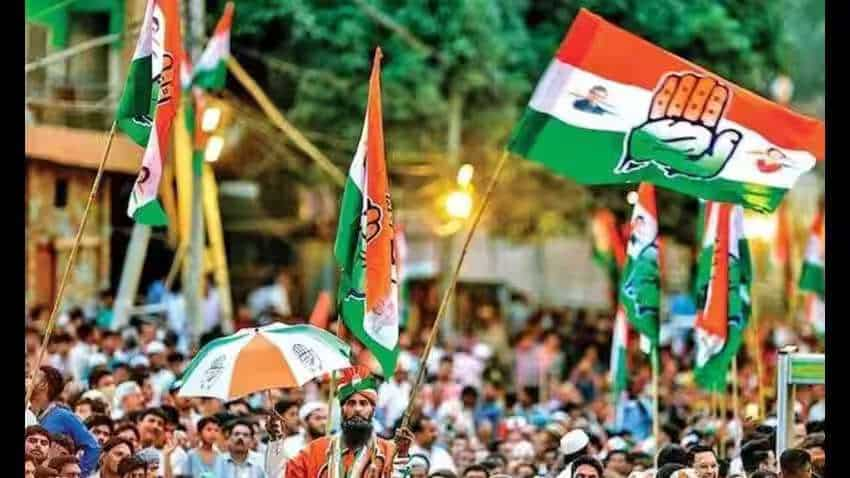
A Few Least Discussed Curious Aspects re: Karnataka Elections in India
Don't Miss
Sandeep Banerjee, Countercurrents, 17 May 2023 : As the ‘media’ is so skewed in these days we may count on social media for a variety of views. Some days have passed after the Karnataka results came out and we know scores of different views and analyses through the social media. Yet we find few aspects neglected, which would have rather demanded more mentions and attention. (1) One is the brilliant forecast and analysis done by the EEDINA group, a study led by Professor Yogendra Yadav, and (2) How far we can get ‘BJP Mukt’ this or that state or India as a whole, how much fascism can be cornered electorally, examining election results of some states.
Yogendra Yadav’s and Eedina’s Brilliant Survey
(I must thank friend Vasu V, who sent me that perhaps more than a couple of weeks ahead of the result declaration.) Eedina study was in Kannada and Prof Yogendra Yadav wrote a very brief article that was published in The Print on April 28, 2023.
That survey predicted 132-140 seats for INC, 57-65 seats for BJP and 19-25 seats for JD(S). Who else predicted more correctly? And it was not guesswork. Their survey was done among a big sample, perhaps bigger than any other so-called market research organisations. At least for this reason this analysis begs rereading and that would give us some very good insight into Indian societies.
The title of Yogendra Yadav’s article was also another aspect for which it demanded more attention: “Class matters in Karnataka – Eedina’s pre-poll survey on voting patterns shows” and the second heading was “Politicians & political analysts are focused on communal polarisation & caste cleavages, but a deeper class divide is silently reconfiguring the Indian electorate.” This, Yogendra Yadav was writing at the fag end of this year’s Dalit History Month and yet it was not duly recognised!
Another very interesting feature is the way they marked class boundaries and percentage of the populace in a particular class.
- The UPPER Class has 4% share in population,
- the MIDDLE Class has 10%,
- the LOWER MIDDLE 26%,
- the POOR Class 37% and
- the VERY POOR Class 23% and this classification was based on occupation-income-asset of respondents.
- And BJP’s chance of getting vote was 41% – 38% – 36% – 32% – 28% as you go down the class ladder,
- while Congress’s chance of getting vote was 29% – 37% – 39% – 46% – 48% as you go down the class ladder.
So, these classes are not arbitrarily some monetised amounts but also, they imply different political behaviour. These may not be classes according to production relations in its strict sense, but this classification still makes sense from one angle — how these classes are faring in the present socio-economic setting, under the present economic policies (in de-facto level).
It also shatters the so-called 99% vs 1% myth — the present and more importantly the future class struggles will have different numerical strengths as were in the past big class struggles, revolutionary struggles.
BJP–Mukt! Routing Fascism! Really? How far?
Already there is a joyous celebration in the social media for a ‘BJP Mukt Karnataka’ and ‘BJP Mukt South’. How many states are not non-BJP (ruled) and what percentage of Indians are living in non-BJP states are already in circulation along with colourful maps showing towards how much non-saffron India we are moving. But can we think a bit deeper for a few minutes only? How much setback did BJP really suffer in Karnataka? Let us look as this chart below:
So, BJP vote share started growing steeply through the Babri-turmoil Babri-demolition phase; during Vajpayee days including Gujarat riot days it also grew significantly –— and since 2009 it never went below 33-34% – this is very significant; let us not forget that the two teams of BJP together reaped more than 37% in 2013 (the A team got what is shown here, 29.70%, while the B team got 9.80%, later these two merged again). Also let us not forget that once there was a short-lived alliance of JD(S) and BJP, which shows the real anti-Hindutva or anti-Fascist nature of many opposition parties.
Can this at all be called a BJP-Mukt condition? Let us see BJP’s rise or fall in two other states — Tripura and Kerala by two charts below:
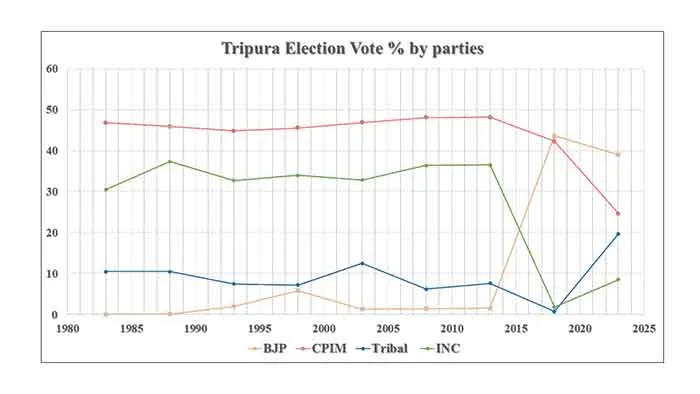 |
| Picture 2: Vote share of BJP and other political forces in Tripura, 1983-2022 |
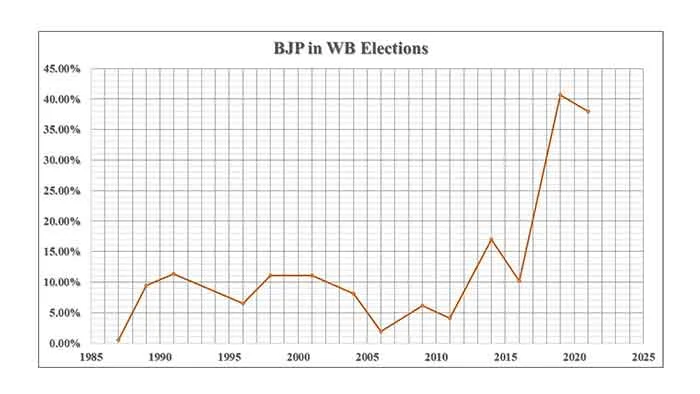 |
| Picture 3: Vote share of BJP in West Bengal, 1987-2022 |
There is a little similarity in the shapes of BJP-curve in these two large Bangla speaking states. BJP was never Zero, it started rising after Babri episode and got a sharp rising trend after 2014 simultaneous with sharp decline of vote share of so-called left and centre. There was decline in BJP vote share in the recent-most election, but that is not very large. With more than a third of the electorate under the so-called politics-of-hate can we really say, that politics-of-love/unity is now in a safe position? Moreover, we know that a certain percentage of votes swung to the main opposition (in Karnataka) with economic distress as a major driving force.
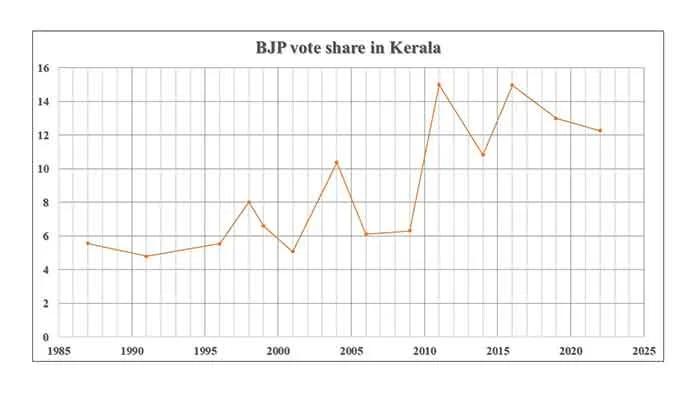 |
| Picture 4: Vote share of BJP in Kerala, 1987-2022 (NB: in years when both assembly and parliamentary elections took place an average is taken) |
Here also we see ups and downs by overall there is a tendency of increase – one ‘down’ is more than the previous ‘down’ in general. Moreover, what is alarming, BJP/NDA is in second position is about half a dozen assembly segments, even if it did not get any seat yet.
Are we, through electoral politics, moving towards wiping-out-of-fascism at all? Or fascist tendency, hatred towards minorities is on the increase? Can we feel safe just by a change in government?
NB: Moreover, change in govt is a dubious matter – as parts of the state machinery – the administration to everything – are already under saffron virus infection to some extent or other. What change by voting are MLAs, MPs, Cabinets (ministry) and nothing more.
The author is an activist who writes on political and socioeconomic issues and also on environmental issues. Some of his articles are published in Frontier Weekly. He lives in West Bengal, India. Presently he is a research worker. He can be reached at sandeepbanerjee00@gmail.com

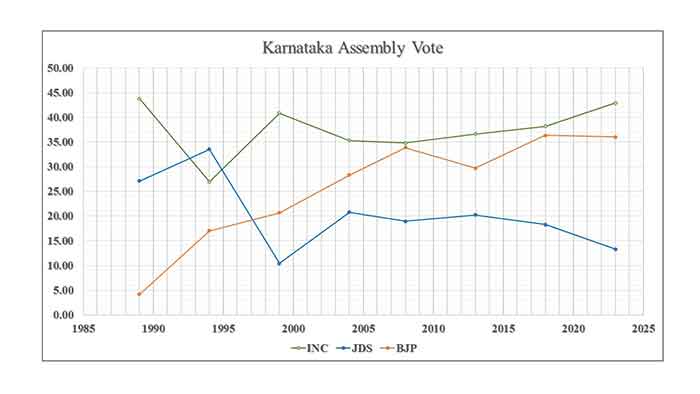

0 Response to " A Few Least Discussed Curious Aspects re: Karnataka Elections in India"
Post a Comment
Disclaimer Note:
The views expressed in the articles published here are solely those of the author and do not necessarily reflect the official policy, position, or perspective of Kalimpong News or KalimNews. Kalimpong News and KalimNews disclaim all liability for the published or posted articles, news, and information and assume no responsibility for the accuracy or validity of the content.
Kalimpong News is a non-profit online news platform managed by KalimNews and operated under the Kalimpong Press Club.
Comment Policy:
We encourage respectful and constructive discussions. Please ensure decency while commenting and register with your email ID to participate.
Note: only a member of this blog may post a comment.